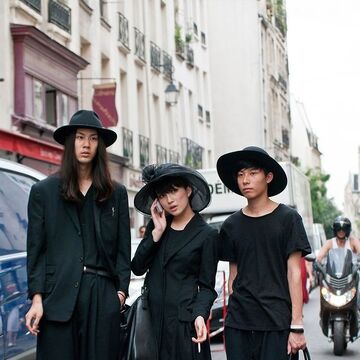Japanese Zoku: Finding Your Tribe
The literal definiton of the Japanese suffix “-zoku” translates to “tribe”. However, it takes on a more nebulous meaning when describing subcultures in modern and contemporary Japan. Take the “bosozoku“, or motorcycle gangs. One of Japan’s more commonly known zoku, they took inspiration from American chopper motorcycles and greaser culture.
In this three-part series, we’ll introduce some other Japanese zoku that people outside Japan may be less familiar with. These lists are general overviews and are by no means exhaustive. For this first part, we will look at three subcultures in relation to fashion.
“Taiyo-zoku”- The Fabled Young and the Restless
The taiyozoku, or Sun Tribe, describes a sensationalized subculture of wealthy and bored young adults who embraced more rebellious lifestyles than their predecessors post-World War II. The name comes from Season of the Sun, a classic novel by Ishihara Shintaro, a decorated novelist and controversial politician.
At any rate, the taiyozoku were often characterized as flamboyant do-nothings, analogous to the beatniks of San Franscisco. Like most adolescents of that time, the taiyozoku were disillusioned by the harshness of World War II, and empowered by the following economic boom.
As is often the case after a major international war, there was indeed a change in social norms. The taiyozoku were unique because they seemed more like a hysterical concept of the media at the time, rather than an accurate depiction of post-war youth. Despite this, these portrayals of youth who partied and engaged in casual sex and street fights resonated heavily with college students–especially since they were protesting at the time.
The legacy of the taiyozoku now solely lies in films such as Season of the Sun, Crazed Fruit and Backlight. The films themselves were also notable for breaking away from cinematic norms. Opting for medium shots and talking head scenes, they immersed their audience in the characters’ world, especially their ennui.
“Takenoko-zoku”- Brightly Colored Street Dancers
The takenokozoku was a dancing subculture that lasted from the late 1970s to the early 1990s. The name comes from their signature dance, the “bamboo shoot”. The takenokozoku were a group of teenagers and young adults who wore brightly colored costumes–namely with baggy harem pants–and danced in and around Yoyogi Park, just a few steps away from the burgeoning Harajuku neighborhood.
Planning a trip to Japan? Get an authentic, interpreted experience from Unseen Japan Tours and see a side of the country others miss!

"Noah [at Unseen Japan] put together an itinerary that didn’t lock us in and we could travel at our own pace. In Tokyo, he guided us personally on a walking tour. Overall, he made our Japan trip an experience not to forget." - Kate and Simon S., Australia


Keep all you devices connected in Japan - rent a pocket wifi device! Available for hotel pickup or delivered to your airport. Fast speeds and backed by excellent customer service. (Note: Affiliate link - Unseen Japan earns a commission if you make a purchase.)
Harajuku would later become a hub for youth-fashion in the 80s and 90s. In that sense, one could even call the takenokozoku a precursor to Tokyo counterculture. Their dances took great inspiration from Shinto festival dances (think: Obon dance) and disco music, which was very popular during that time period.
THE 竹の子族 THE TAKENOKOZOKU 1980s Japanese Street Dance Groups
昔友達に誘われて数回ホコ天に踊りに行った記憶がある。詳しい事は全く覚えていないけど面白かった。今回、YOU TUBEで動画と曲を集めて、竹の子族のMV作成に挑戦❗(アスペクト比を16:9に変えた為、画質は良くない)チャンネル登録・評価ボタン 不要❗❗ネット世代、必見 ❗ これが昭和のパワーだぁ ❗ チャレンジ魂…
Sadly, local authorities cracked down on street dances for their use of boomboxes and sound systems set up in trucks. Because of this, the subculture began to die out, as noisy public gatherings were heavily discouraged. However, the spirit of the takenokozoku live on in the seminal gyaru subculture, as well as the rockabilly dancers who still perform on a regular basis in Yoyogi Park.
“Karasu-zoku”- A Murder of All-Black Crows
The karasu-zoku, meaning “crow tribe”, was a subculture based on all-black clothing. Though it’s understandably tempting to draw a 1:1 comparison between karasu-zoku and the goth aesthetic, the actual origins of karasu-zoku are slightly more nuanced.
Created in the 1980s as an antithesis to the burgeoning kawaii culture, karasu-zoku was an androgynous and assertive take on street fashion. Notable fashion designers Yamamoto Yohji and Kawakubo Rei were some of the first designers to formulate this aesthetic, with the former describing the color black as both “modest and arrogant” at the same time.
The all-black silhouettes were also baggy, and rebelled against the body-conscious silhouettes in Europe. This gave women the ability to live independent from the male gaze. In other words, the dark, heavy silhouettes shrouded the wearers in mystery, opposing them from societal expectations of male accessibility.
Throughout the 80s and 90s, the karasu-zoku style became synoymous with luxury Japanese fashion. Some even credit it as the origin of all-Black New York fashion of the 2000s as well.
What other fashion/music subcultures or “zoku” would you like to know more about? Let us know on social media!


